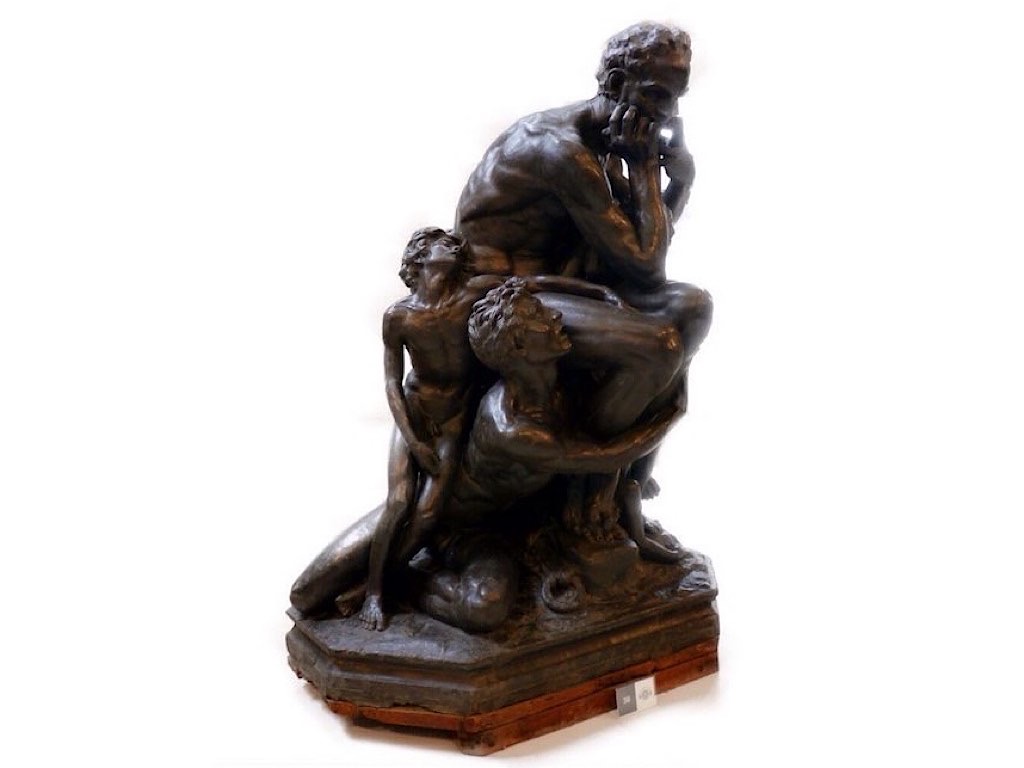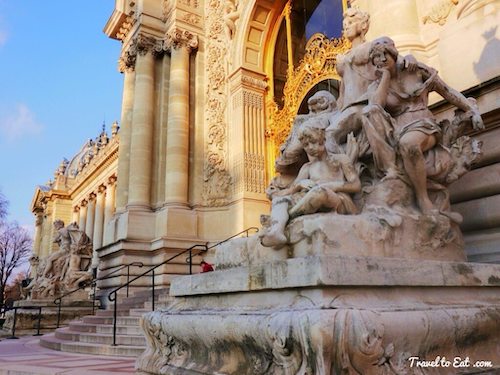
The Petit Palais was built for the 1900 Universal Exhibition, like its neighbour the Grand Palais, on avenue Winston Churchill. It became a museum in 1902, housing the City of Paris Museum of Fine Arts (Musée des Beaux-Arts de la Ville de Paris). Designed by Charles Girault, it is based on a trapezium shape and is made up of four wings around a semi-circular garden bordered by a richly decorated peristyle. The tympanum depicting the city of Paris surrounded by muses is the work of sculptor Jean Antoine Injalbert. The main entrance gate, designed by Girault himself, was immediately praised for its elegance and the virtuosity of its craftsmanship.
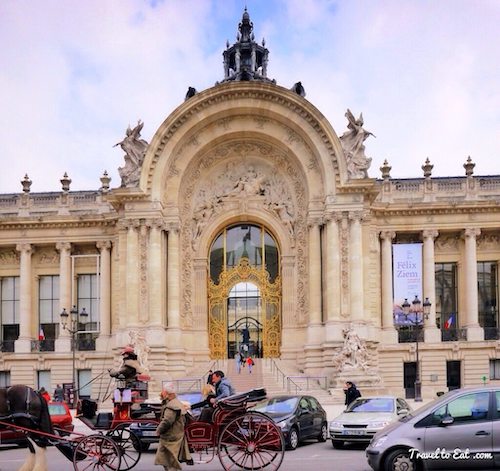
The collection ranges from Greek and Roman antiquities to art from the early 1900s, when the building was constructed. Much of the collection was a legacy to the city from collector Auguste Dutuit and his brother Eugène. The Petit Palais houses one of France's largest collections of Dutch paintings, after that of the Louvre. The works from 1900 emphasize sculpture, which was very popular at the time, as well as Impressionism, Symbolism, and Art Nouveau.
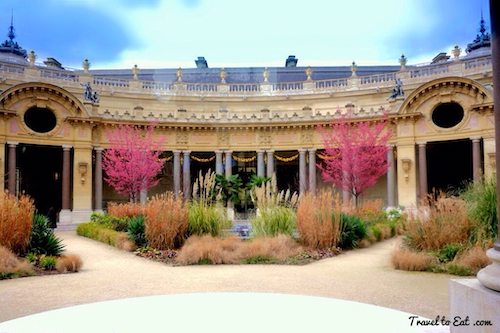
The garden peristyle and the edges of the three ponds have also been decorated with little blocks of marble and fountains.
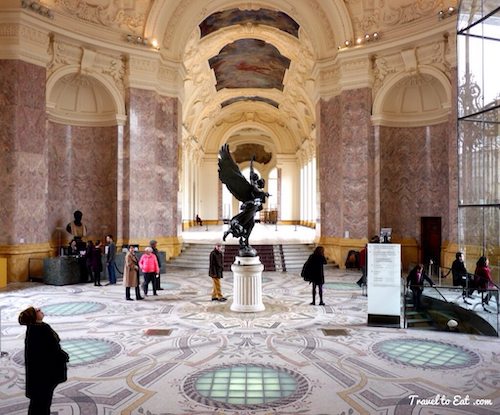
As you enter, you are greeted by this lovely entrance lobby. The floor surface was created by Facchina (1826-1923), the famous Italian mosaic artist.
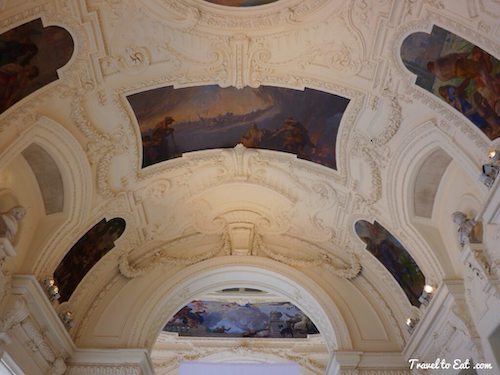
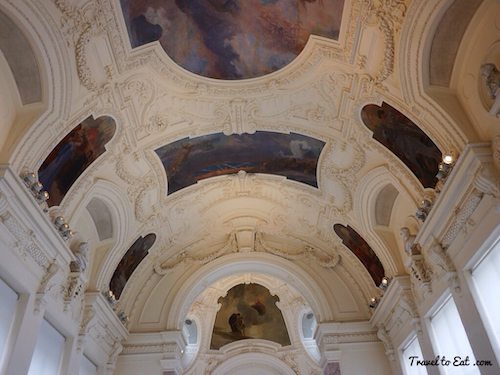
Cormon and Roll were both given the task of decorating the gallery ceilings which are 15 meters long. From 1906 to 1911, Cormon retold the story of Paris through history, from the battle of Lutetia up to the French Revolution. Roll, by contrast, was given the job of illustrating modern Paris. Directly above the main galleries, there are sixteen plaster busts set into the wall representing famous artists including Eugène Delacroix, Pierre Lescot and François Mansart.
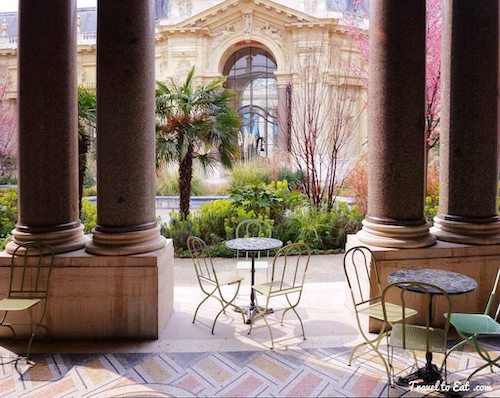
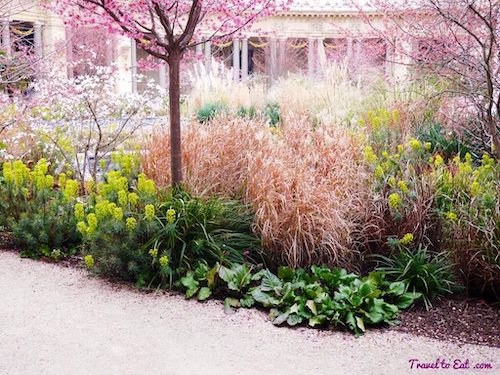


Around the garden is this lovely portico faced in marble with the same mosaic floors. They also have a little self service café.
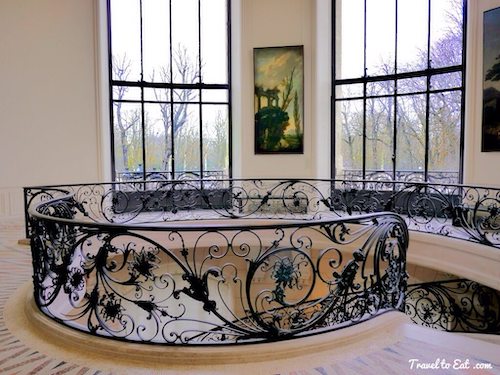
Here is the stairway with two windows showing the beginning of spring outside. I really love that bannister.
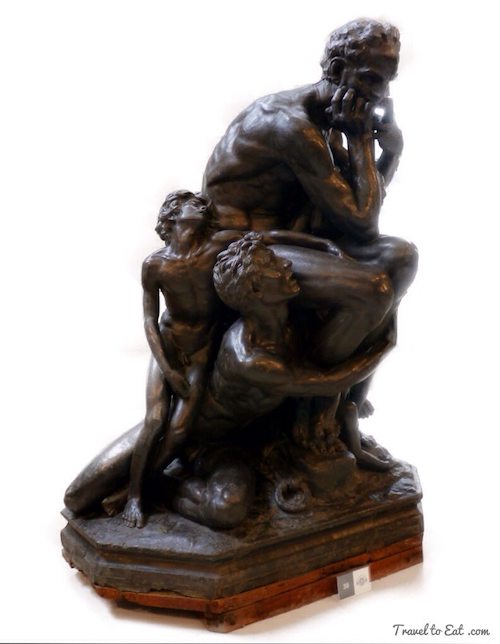
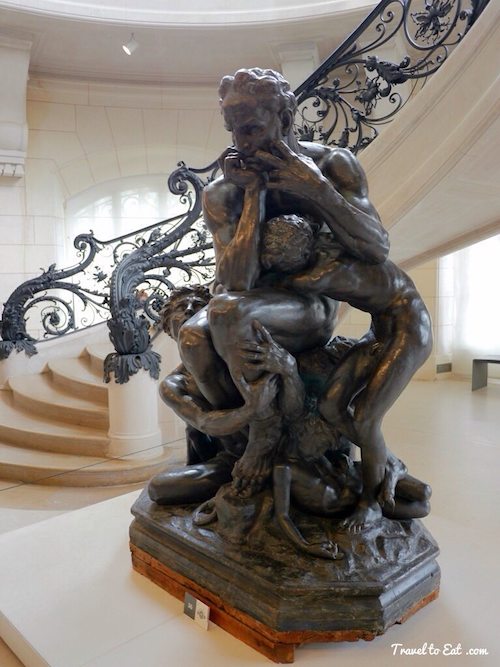
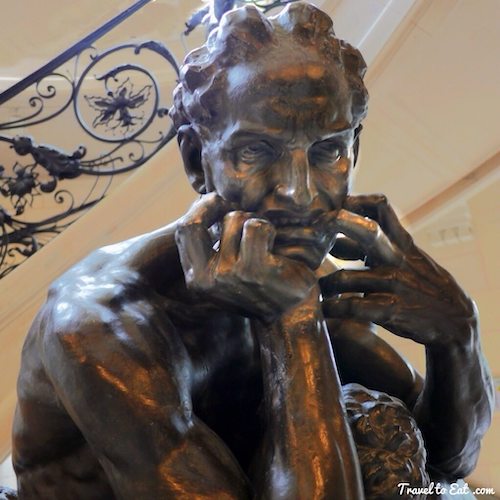
At the bottom of the stairwell is this beautiful bronze statue of Ugolino and his Sons by Jean-Baptiste Carpeaux done in 1862. Note the large muscular hands and body reminiscent of Michelangelo. The subject is taken from Dante's Divine Comedy, the poet describes the tyrant Ugolino of Pisa, chained in the Tower of Hunger with his four sons (Canto XXXIII):
“…When a little ray entered the woeful prison, and I discerned by their four faces my own very aspect, both my hands I bit for woe; and they, thinking I did it through desire of eating, of a sudden rose, and said, 'Father, it will be far less pain to us if thou eat of us; thou didst clothe us with this wretched flesh, and do thou strip it off.”
“…Here he died: and, even as thou seest me, I saw the three fall one by one between the fifth day and the sixth; then I betook me, already blind, to groping over each, and two days I called them after they were dead: then fasting had more power than grief.”
Dante pictures Ugolino in the darkest possible terms but Ugolina was a real figure from history and this is based on an actual event (although I doubt he was a cannibal). Count Ugolino della Gherardesca (1220-1289), count of Donoratico, was an Italian nobleman, politician and naval commander from Pisa in Italy. He was frequently accused of treason and features prominently in Dante's Divine Comedy. In 1288 Ugolino together with his sons Gaddo and Uguccione and his grand-sons Nino and Anselmuccio were detained in the Muda, a tower belonging to the Gualandi family. In March 1289, on orders of the Archbishop, who had proclaimed himself podestà of Pisa, the keys were thrown into the Arno river and the prisoners left to starve, pretty gruesome.
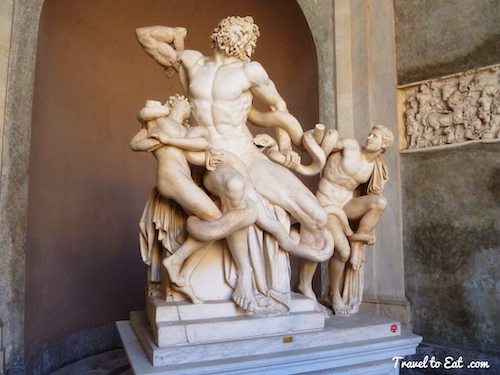
Ugolino and his Sons is a very influential sculpture whose composition shows a classical Italian Renaisance influence. The tangle of bodies is reminiscent of Laocoön and His Sons from about 40 BC in the Vatican. The story of Laocoön had been the subject of a play by Sophocles (the play is now lost), and was mentioned by other Greek writers. Laocoön was killed after attempting to expose the ruse of the Trojan Horse by striking it with a spear. The discovery of the Laocoön in 1506 made a great impression on Italian sculptors and significantly influenced the course of Italian Renaissance art. Michelangelo is known to have been particularly impressed by the massive scale of the work. I have written a post a few years ago on Laocoön, but it was removed in the remodel of the website, I will try to repost.
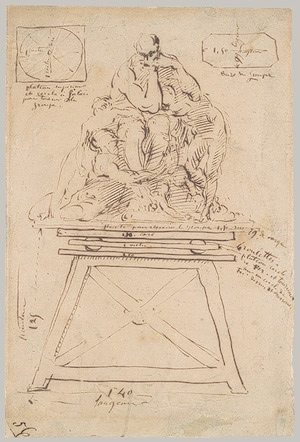
At Villa Medici in January 1856, Carpeaux began a five-year curriculum in which the completion of various assignments of increasingly complex sculptures and bas-reliefs was required. Carpeaux was especially receptive to the works of Michelangelo, whose gestural poses he observed carefully and incorporated into his own design for a fifth-year assignment. This work caused a sensation in Rome and the boldness and vigor of Carpeaux's dramatic rendition contrasted sharply with the prevailing Neoclassical formulae of the French Academy. It immediately established Carpeaux as the heir of the Romantic sculptors of the 1830s.
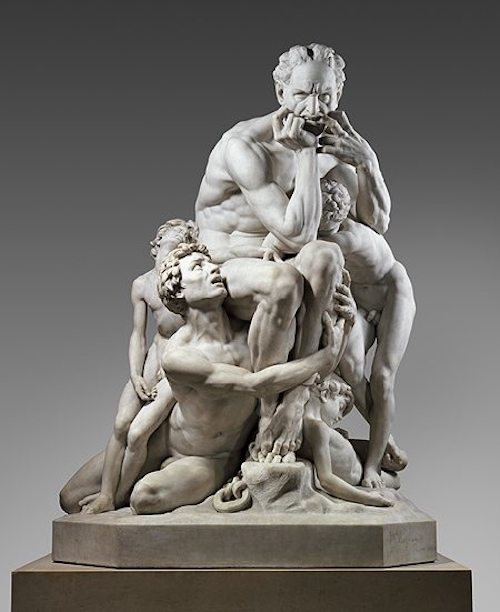
After lengthy delays and struggles with officialdom, the French Ministry of Fine Arts commissioned a bronze cast by Victor Thiébaut and placed it in the Tuileries Gardens as a pendant to a bronze copy of the Laocoön. Carpeaux also executed the work in marble and displayed it at the Exposition Universelle of 1867 in Paris, where it won first prize for sculpture. The marble statue is now at the Metropolitan Museum of Art, a bronze is in the D'Orsay and there is the bronze at the Petit Palais. This bronze statue at the Petit Palais is all the sweeter because the D'Orsay has the miserable policy of no photos and no photos from the website.
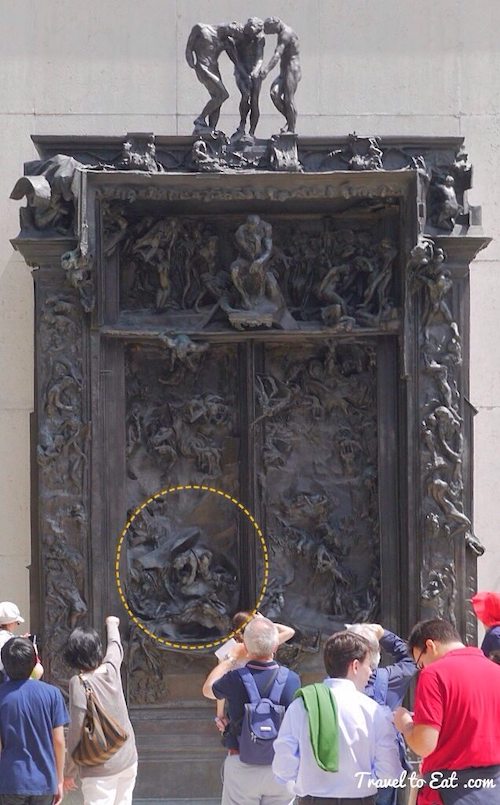
In his group on La Porte de l'Enfer (Gates of Hell), Rodin depicted the dramatic scene just before it reached its climax, Ugolino is crawling over the bodies of his dying children, but has not yet given in to his bestial instincts. Naked, grimacing, on all fours, this desperate man has lost all sense of human dignity. Notice that Rodin has avoided the triangular grouping of Carpeaux opting instead for a more horizontal sculture. His pose was both humiliating and original in the art of Rodin’s day. He placed this group in a prominent position on The Gates of Hell, and then decided to have a freestanding version of it cast. The statue is set in the middle of the reflecting pool at the Rodin Museum. In 1863, Rodin had joined the Union Centrale des Arts Décoratifs and, impressed by Carpeaux's work, had tried to socialize with the successful sculptor, who did not return his attentions.
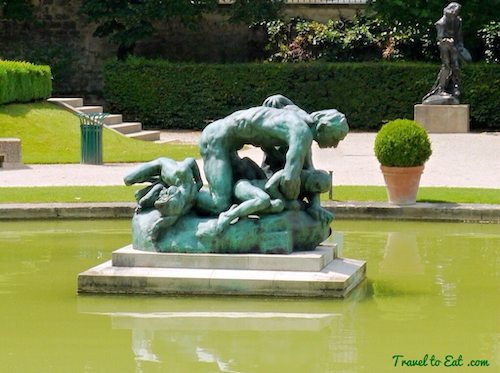
Instead of repeating the traditional pyramidal construction, employed by Carpeaux, Rodin around 1881-82 introduced a daring horizontal composition showing the exhausted old man on all fours, blindly groping for his suffering progenity. The plaster in the Musée d'Orsay shows Ugolino still with a raised head; in the final version, included in “The Gates of Hell', the sculptor goes the last step: the Count is facing down like an animal, no longer able to maintain a reflective distance; as a last human gesture, his left arm is supporting the head of his dying son, the other son still clinging to his father's back.


Now we get to the really interesting bit. Created in 1880 in its original size, about 70 cm, to decorate the tympanum of La Porte de l'Enfer (Gates of Hell), Le Penseur (The Thinker) was then called Le Poète (The Poet): it represented Dante, author of The Divine Comedy that inspired La Porte leaning forward to watch the circles of Hell meditating on his work. Thinker was therefore initially imagined to be both a tortured body, almost a damned man and a free spirit determined to transcend his suffering through poetry. You can really see the influence of the Carpeaux Ugolino. I will also mention the influence of the portrait of Lorenzo de Medici sitting at his tomb, sculpted by Michelangelo in the Medici Chapel, Church San Lorenzo, in Florence, seen above.
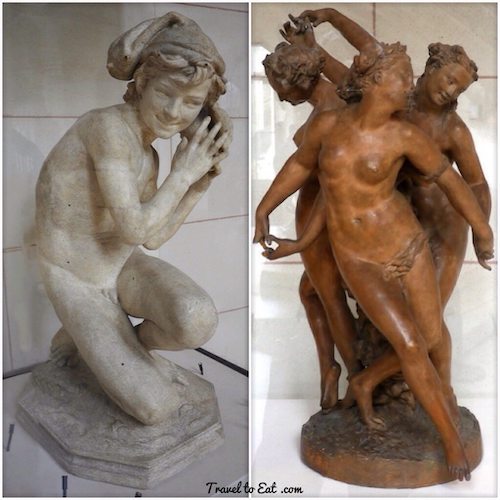
I am going to close this with two other famous works by Carpeaux exhibited at the bottom of the same stairwell. Carpeaux created his first masterpiece in 1856, “Neapolitan Fisherboy with a Shell” (Musée des Beaux-Arts, Valenciennes) in his first year at the Villa Medici which he subsequently exhibited at the École des Beaux Arts in 1858. In 1833 François Rude, Carpeaux's first teacher, created a stir with his naturalistic ” Neapolitan Fisherboy Playing with a Tortise”. Carpeaux's interpretation of this work, through the child's grace, naïveté, and carefree cheerfulness, paid a vibrant tribute to his master. It was purchased for Napoleon III's empress, Eugènie. The statue of the young smiling boy was very popular, and Carpeaux created a number of reproductions and variations in marble and bronze. His most famous work, “The Dance”, completed in 1869, a sculptural group for the façade of the Paris Opéra (see my post), created a sensation and was attacked as immoral. His works were frequently the subject of hostile criticism, and in his last years he suffered from fears of persecution.

There are more pieces from Carpeaux in the museum, including some busts and some paintings. Consider the Petit Palais if you want to escape the crowds at the Louvre and see some really great art. It is located across from the Grand Palais and just down the street from the Alexander Bridge (see my post). I will stop here, but I will have more from the museum.
References:
Official Site: http://www.petitpalais.paris.fr/en
Metropolitan Museum Uglolino Analysis: http://www.metmuseum.org/toah/hd/carp/hd_carp.htm
Robert Baron Ugolino from the Met (nice photo set): http://www.studiolo.org/MMA-Ugolino/Ugolino.htm
Musée Rodin Uglolino: http://www.musee-rodin.fr/en/collections/sculptures/ugolino-and-his-children
Rodin Ugolino: http://rodin-web.org/works/1876_ugolino.htm
Fisherboy with Shell: http://www.p-synd.com/carpeaux.htm
Fisherboy with Tortise: http://www.louvre.fr/en/oeuvre-notices/young-neapolitan-fisherboy-playing-tortoise

